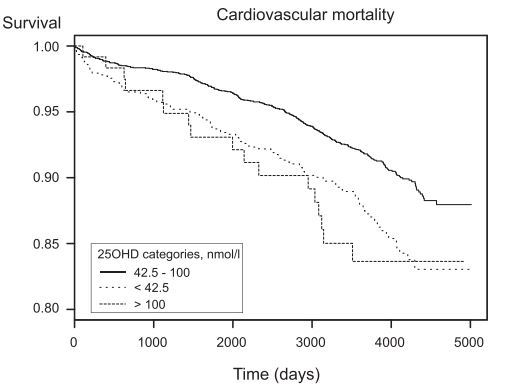Cardiovascular death 40 percent more likely in a decade if chest pain and low Vitamin D
Plasma 25-Hydroxyvitamin D and Mortality in Patients With Suspected Stable Angina Pectoris
The Journal of Clinical Endocrinology & Metabolism, Volume 103, Issue 3, 1 March 2018, Pages 1161–1170, https://doi.org/10.1210/jc.2017-02328
Eirik Degerud Ottar Nygård Stefan de Vogel Rune Hoff Gard Frodahl Tveitevåg Svingen Eva Ringdal Pedersen Dennis Winston Trygve Nilsen Jan Erik Nordrehaug Øivind Midttun Per Magne Ueland

PDF was available free at Sci-Hub.tv as of March 2018
Context and Objective
Vitamin D status may affect cardiovascular disease (CVD) development and survival. We studied the relationship between concentrations of the circulating biomarker 25-hydroxyvitamin D (25OHD) and all-cause and cardiovascular mortality risk.
Design, Setting, Participants, and Main Outcome Measures
25OHD, the sum of 25-hydroxyvitamin D3 and 25-hydroxyvitamin D2, was analyzed in plasma samples from 4114 white patients suspected of having stable angina pectoris and was adjusted for seasonal variation. Hazard ratios (HRs) for all-cause and cardiovascular mortality were estimated by using multivariable Cox models with 25OHD as the main exposure variable, with adjustment for study site, age, sex, smoking, body mass index, estimated glomerular filtration rate, and systolic blood pressure.
Results
A total of 895 (21.8%) deaths, including 407 (9.9%) from CVD causes, occurred during a mean ± standard deviation follow-up of 11.9 ± 3.0 years. Compared with the first 25OHD quartile, HRs in the second, third, and fourth quartiles were
0.64 (95% confidence interval (CI), 0.54 to 0.77),
0.56 (95% CI, 0.46 to 0.67), and 0.56 (95% CI)
0.46 to 0.67) for all-cause mortality
and
0.70 (95% CI, 0.53 to 0.91),
0.60 (95% CI, 0.45 to 0.79), and
0.57 (95% CI, 0.43 to 0.75)
for cardiovascular mortality, respectively.
Threshold analysis demonstrated increased all-cause and CVD mortality in patients with 25OHD concentrations below ∼42.5 nmol/L. Moreover, analysis suggested increased all-cause mortality at concentrations >100 nmol/L.
Conclusion
Plasma 25OHD concentrations were inversely associated with cardiovascular mortality and nonlinearly (U-shaped) associated with all-cause mortality.
